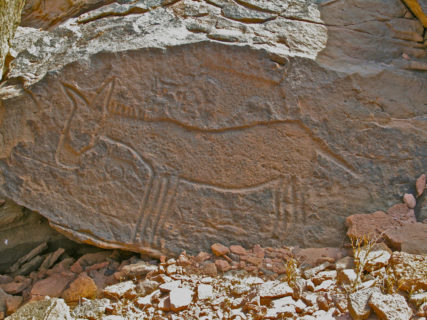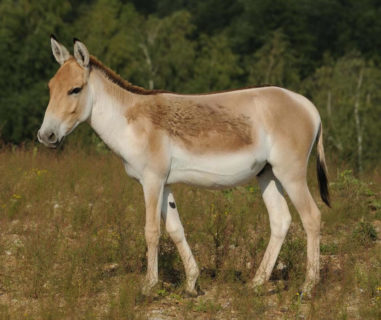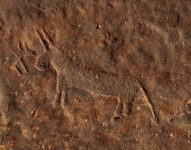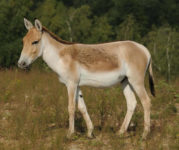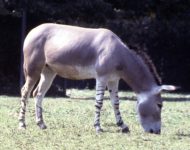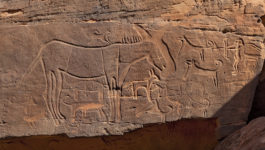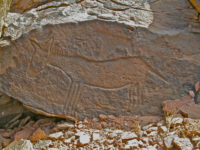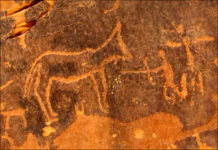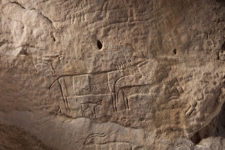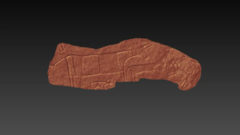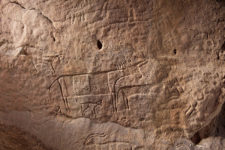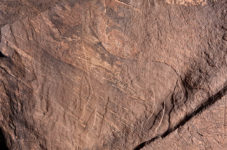 The wild equine that is depicted in Arabian rock art could have been either the African wild ass (Equus africanus) or the Near Eastern onager, (E. hemionus). Until adequate skeletal remains are found in archaeological sites this question remains open. It is possible that both species occurred in different regions of the Arabian Peninsula. The onager is definitely documented from the north through the central region of Saudi Arabia. The rock art shows asses/onagers being hunted by bow hunters and their packs of dogs. Some of the animals are shown just as individual figures without content, but they are not depicted as obviously domesticated donkeys. Although there are some later images, such as at Qaryat al-Asba, most of the asses/onagers are shown on Neolithic panels.
The wild equine that is depicted in Arabian rock art could have been either the African wild ass (Equus africanus) or the Near Eastern onager, (E. hemionus). Until adequate skeletal remains are found in archaeological sites this question remains open. It is possible that both species occurred in different regions of the Arabian Peninsula. The onager is definitely documented from the north through the central region of Saudi Arabia. The rock art shows asses/onagers being hunted by bow hunters and their packs of dogs. Some of the animals are shown just as individual figures without content, but they are not depicted as obviously domesticated donkeys. Although there are some later images, such as at Qaryat al-Asba, most of the asses/onagers are shown on Neolithic panels.
Onager, Equus hemionus
Height: 120 cm (48 in)
Weight: 200-260 kg (440-575 lb)
Description
The onager, also known as the kulan, is very similar in appearance to the African wild ass/domestic donkey, but overall it is more horse-like, with more slender legs than the African species. Its coat is more of a red to light fawn dun and may have faint, light-colored zebra striping on the legs. The onager has an eel stripe down its back with a narrow white strip on either side. There have been statements about how they can be distinguished from African asses in art by their tail, but observations of living African asses and onagers show a wide range of variation in the tails of both. Either can have the tuft emerging halfway down the tail or closer to the tip.
Habitat
The onager or Asian wild ass inhabits regions with mountain steppe, steppe, semi-desert and desert plain environments, with preference for the desert steppe. They are typically grazers, but will browse on woody vegetation when necessary. They can be found in rocky and sandy areas. Population density depends on water resources, with herds ranging upward to 1200 individuals over a large area.
Distribution
In the past, the onager was widely distributed from the northern half of Arabia, to Syria, Jordan, Israel, Iraq, Iran, Afghanistan, Pakistan, NW India, Central Asia, NW China, Mongolia and S Siberia. Today that range has significantly shrunk. The subspecies (E. hemionus onager) that has been “reintroduced” into Saudi Arabia is different from the subspecies that originally occurred there, the Syrian wild ass (E. hemionus hemippus). It is now extinct.
African Wild Ass: Equus africanus
Height: 125-145 cm (51-59 in)
Weight: 230–275 kg (510–610 lb)
Description
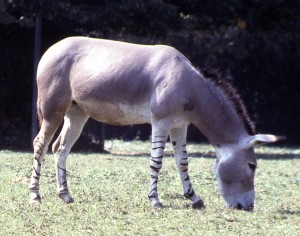 The African wild ass is a small equine with large ears, thick muzzle, erect mane, a gray to fawn dun coat, a faint eel stripe down the back, sometimes a faint crossbar on the withers, and, in the case of the Somali subspecies, dark striping on the legs. The tail has a tuft of longer hairs at the end. The wild ass can run 50 km/h (30 mph), and kick with its hind legs or rear up and use its forelimbs for defense.
The African wild ass is a small equine with large ears, thick muzzle, erect mane, a gray to fawn dun coat, a faint eel stripe down the back, sometimes a faint crossbar on the withers, and, in the case of the Somali subspecies, dark striping on the legs. The tail has a tuft of longer hairs at the end. The wild ass can run 50 km/h (30 mph), and kick with its hind legs or rear up and use its forelimbs for defense.
The African wild ass is the ancestor of our modern domestic donkey, E. asinus. The oldest evidence for the domestic donkey is in Egypt, dating to about 3,000 BCE.
Habitat
African wild asses are adapted to arid and semiarid bushland and grassland habitats and have a digestive system that can extract moisture and nutrients from desert vegetation. They can survive up to three days without drinking water. The sparse vegetation of their environment necessitates a dispersed distribution of individuals over the landscape and solitary behavior, apart from mothers and offspring. Dominant males are territorial, but tolerate subordinate males. Herds today do not typically exceed 50 individuals and are widely dispersed. Although much of their habitat is flat and monotonous, they are skilled at navigating rough, rocky terrain.
Distribution
The African wild ass once had a large range that extended from the High Atlas Mountains of Morocco to the Arabian Peninsula, but today it is found only in small pockets in Eritrea, Ethiopia and Somalia, with occurrences possible still in Egypt, Djibouti, and Sudan.
